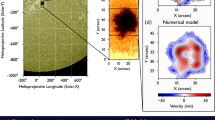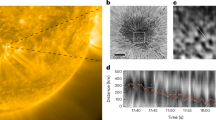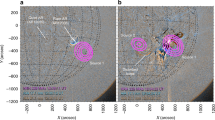Abstract
Alfvén waves have proven to be important in a range of physical systems due to their ability to transport non-thermal energy over long distances in a magnetized plasma. This property is of specific interest in solar physics, where the extreme heating of the atmosphere of the Sun remains unexplained. In an inhomogeneous plasma such as a flux tube in the solar atmosphere, they manifest as incompressible torsional perturbations. However, despite evidence in the upper atmosphere, they have not been directly observed in the photosphere. Here, we report the detection of antiphase incompressible torsional oscillations observed in a magnetic pore in the photosphere by the Interferometric Bidimensional Spectropolarimeter. State-of-the-art numerical simulations suggest that a kink mode is a possible excitation mechanism of these waves. The excitation of torsional waves in photospheric magnetic structures can substantially contribute to the energy transport in the solar atmosphere and the acceleration of the solar wind, especially if such signatures will be ubiquitously detected in even smaller structures with the forthcoming next generation of solar telescopes.
This is a preview of subscription content, access via your institution
Access options
Access Nature and 54 other Nature Portfolio journals
Get Nature+, our best-value online-access subscription
$29.99 / 30 days
cancel any time
Subscribe to this journal
Receive 12 digital issues and online access to articles
$119.00 per year
only $9.92 per issue
Buy this article
- Purchase on Springer Link
- Instant access to full article PDF
Prices may be subject to local taxes which are calculated during checkout




Similar content being viewed by others
Data availability
The IBIS data that support the plots within this paper and other findings of this study can be downloaded from the IBIS-A archive http://ibis.oa-roma.inaf.it/IBISA/database/.
Code availability
LareXd is a set of Lagrangian remap codes for MHD simulations. The open source code is available for download from https://warwick.ac.uk/fac/sci/physics/research/cfsa/people/tda/larexd/.
References
Alfvén, H. Existence of electromagnetic–hydrodynamic waves. Nature 150, 405–406 (1942).
Bahcall, J. N. & Bethe, H. A. Solution of the solar-neutrino problem. Phys. Rev. Lett. 65, 2233–2235 (1990).
Erdélyi, R. & Fedun, V. Are there Alfvén waves in the solar atmosphere? Science 318, 1572–1574 (2007).
Liu, J., Nelson, C. J., Snow, B., Wang, Y. & Erdélyi, R. Evidence of ubiquitous Alfvén pulses transporting energy from the photosphere to the upper chromosphere. Nat. Commun. 10, 3504 (2019).
Vasconcelos, M. J., Jatenco-Pereira, V. & Opher, R. Alfvenic heating of protostellar accretion disks. Astrophys. J. 534, 967–975 (2000).
McKee, C. F. & Zweibel, E. G. Alfven waves in interstellar gasdynamics. Astrophys. J. 440, 686 (1995).
Ebisuzaki, T. & Tajima, T. Astrophysical ZeV acceleration in the relativistic jet from an accreting supermassive blackhole. Astropart. Phys. 56, 9–15 (2014).
Hasegawa, A. & Chen, L. Kinetic processes in plasma heating by resonant mode conversion of Alfvén wave. Phys. Fluids 19, 1924–1934 (1976).
Chen, L. & Hasegawa, A. Plasma heating by spatial resonance of Alfvén wave. Phys. Fluids 17, 1399–1403 (1974).
Spruit, H. C. Propagation speeds and acoustic damping of waves in magnetic flux tubes. Sol. Phys. 75, 3–17 (1982).
Mathioudakis, M., Jess, D. B. & Erdélyi, R. Alfvén waves in the solar atmosphere. From theory to observations. Space Sci. Rev. 175, 1–27 (2013).
Jess, D. B. et al. Alfvén waves in the lower solar atmosphere. Science 323, 1582–1585 (2009).
Kohutova, P., Verwichte, E. & Froment, C. First direct observation of a torsional Alfvén oscillation at coronal heights. Astron. Astrophys. 633, L6 (2020).
Velli, M. & Pruneti, F. Alfvén waves in the solar corona and solar wind. Plasma Phys. Control. Fusion 39, B317–B324 (1997).
Doorsselaere, T. V., Nakariakov, V. M. & Verwichte, E. Detection of waves in the solar corona: kink or Alfvén? Astrophys. J. 676, L73 (2008).
Cavallini, F. IBIS: a new post-focus instrument for solar imaging spectroscopy. Sol. Phys. 236, 415–439 (2006).
Arber, T. D., Longbottom, A. W., Gerrard, C. L. & Milne, A. M. A staggered grid, Lagrangian–Eulerian remap code for 3-D MHD simulations. J. Comput. Phys. 171, 151–181 (2001).
Pascoe, D. J., Wright, A. N. & De Moortel, I. Coupled Alfvén and kink oscillations in coronal loops. Astrophys. J. 711, 990–996 (2010).
Tsiklauri, D. & Nakariakov, V. M. Wide-spectrum slow magnetoacoustic waves in coronal loops. Astron. Astrophys. 379, 1106–1112 (2001).
Tsiklauri, D. A mechanism for parallel electric field generation in the MHD limit: possible implications for the coronal heating problem in the two stage mechanism. Astron. Astrophys. 455, 1073–1080 (2006).
Roberts, B., Edwin, P. M. & Benz, A. O. On coronal oscillations. Astrophys. J. 279, 857–865 (1984).
Nakariakov, V. M., Pascoe, D. J. & Arber, T. D. Short quasi-periodic MHD waves in coronal structures. Space Sci. Rev. 121, 115–125 (2005).
Dorotovič, I., Erdélyi, R., Freij, N., Karlovský, V. & Márquez, I. Standing sausage waves in photospheric magnetic waveguides. Astron. Astrophys. 563, A12 (2014).
Rees, D. E. & Semel, M. D. Line formation in an unresolved magnetic element—a test of the centre of gravity method. Astron. Astrophys. 74, 1–5 (1979).
Withbroe, G. L. & Noyes, R. W. Mass and energy flow in the solar chromosphere and corona. Annu. Rev. Astron. Astrophys. 15, 363–387 (1977).
Goossens, M., Soler, R., Terradas, J., Van Doorsselaere, T. & Verth, G. The transverse and rotational motions of magnetohydrodynamic kink waves in the solar atmosphere. Astrophys. J. 788, 9 (2014).
Browning, P. K. & Priest, E. R. Kelvin–Helmholtz instability of a phased-mixed Alfven wave. Astron. Astrophys. 131, 283–290 (1984).
Soler, R., Terradas, J., Oliver, R., Ballester, J. L. & Goossens, M. Kelvin–Helmholtz instability in coronal magnetic flux tubes due to azimuthal shear flows. Astrophys. J. 712, 875–882 (2010).
McIntosh, S. W. & Pontieu, B. D. Estimating the ‘dark’ energy content of the solar corona. Astrophys. J. 761, 138 (2012).
van Noort, M., Rouppe van der Voort, L. & Löfdahl, M. G. Solar image restoration by use of multi-frame blind de-convolution with multiple objects and phase diversity. Sol. Phys. 228, 191–215 (2005).
Reardon, K. P. & Cavallini, F. Characterization of Fabry–Perot interferometers and multi-etalon transmission profiles. The IBIS instrumental profile. Astron. Astrophys. 481, 897–912 (2008).
Fisher, R. A. The Design Of Experiments (Oliver & Boyd, 1935).
Linnell Nemec, A. F. & Nemec, J. M. A test of significance for periods derived using phase-dispersion-minimization techniques. Astrophys. J. 90, 2317–2320 (1985).
O’Shea, E., Banerjee, D., Doyle, J. G., Fleck, B. & Murtagh, F. Active region oscillations. Astrophys. J. 368, 1095–1107 (2001).
Torrence, C. & Compo, G. P. A practical guide to wavelet analysis. Bull. Am. Meteor. 79, 61–78 (1998).
Auchère, F., Froment, C., Bocchialini, K., Buchlin, E. & Solomon, J. On the Fourier and wavelet analysis of coronal time series. Astrophys. J. 825, 110 (2016).
Socas-Navarro, H. et al. An open-source, massively parallel code for non-LTE synthesis and inversion of spectral lines and Zeeman-induced Stokes profiles. Astron. Astrophys. 577, A7 (2015).
Vernazza, J. E., Avrett, E. H. & Loeser, R. Structure of the solar chromosphere. III—Models of the EUV brightness components of the quiet sun. Astrophys. J. Suppl. 45, 635–725 (1981).
Acknowledgements
R.E. and M.B.K. are grateful to the Science and Technology Facilities Council (STFC) (UK, grant number ST/M000826/1 and ST/S000518/1). R.E., M.B.K., F.B. and D.D.M. acknowledge support from EU H2020 (SOLARNET grant number 158538). R.E. also acknowledges support from the Chinese Academy of Sciences President’s International Fellowship Initiative (PIFI, grant number 2019VMA0052) and The Royal Society (grant number IE161153). M.S. thanks the Solar Physics and Space Plasma Research Centre (SP2RC), School of Mathematics and Statistics (SoMaS), The University of Sheffield, for the warm hospitality and support received as an MSRC Visiting Research Fellow while carrying out part of this research. M.S. and C.B. acknowledge scientific discussions at the Theo Murphy Discussion Meeting ‘High-resolution wave dynamics in the lower solar atmosphere’, supported by The Royal Society. C.B. would like to thank UK STFC DISCnet for financial support of his PhD studentship. This research utilized Queen Mary’s Apocrita HPC facility, supported by QMUL Research-IT. C.J.N. is grateful to the STFC for the support received to conduct this research through grant number ST/P000304/1. We thank G. Verth for some initial discussions. This research made use of SciPy, NumPy and Matplotlib, community-developed Python packages.
Author information
Authors and Affiliations
Contributions
R.E. devised and proposed the experiment. M.S. worked out the method of data analysis and performed it with assistance from C.J.N. C.B. and D.T. planned, designed and carried out the MHD numerical simulations. R.E., M.S., C.J.N., C.B., D.T. and M.B.K. also helped in the interpretation. D.D.M. and F.B. prepared the observing proposal and calibrated the data with help from M.S. M.S. and R.E. wrote the manuscript with the help of C.J.N., M.B.K., C.B. and D.T. All authors discussed the interpretation of the results.
Corresponding authors
Ethics declarations
Competing interests
The authors declare no competing interests.
Additional information
Peer review information Nature Astronomy thanks Clara Froment and Jianpeng Guo for their contribution to the peer review of this work.
Publisher’s note Springer Nature remains neutral with regard to jurisdictional claims in published maps and institutional affiliations.
Supplementary information
Supplementary Information
Supplementary text including Figs. 1–8.
Supplementary Video 1
A video showing partial fluid streamlines perpendicular to the flux tube at a height of 500 km above the photosphere. The strength of the streamlines is shown by their length and colour as indicated by the colour bar. The streamlines are overlaid on a counter of the density, clearly showing the position of the flux tube. The video clearly shows the formation of torsional motions at the tube boundary.
Supplementary Video 2
A video showing partial fluid streamlines perpendicular to the flux tube at a height of 1 Mm above the photosphere. The strength of the streamlines is shown by their length and colour as indicated by the colour bar. The streamlines are overlaid on a counter of the density, clearly showing the position of the flux tube. The video clearly shows the formation of torsional motions at the tube boundary.
Supplementary Video 3
A video showing partial fluid streamlines perpendicular to the flux tube at a height of 2 Mm above the photosphere. The strength of the streamlines is shown by their length and colour as indicated by the colour bar. The streamlines are overlaid on a counter of the density, clearly showing the position of the flux tube. The video clearly shows the formation of torsional motions at the tube boundary.
Supplementary Video 4
A video showing the field lines of the magnetic perturbation perpendicular to the flux tube at a height of 500 km above the photosphere. The strength of the field lines is shown by their length and colour as indicated by the colour bar. The field lines are overlaid on a counter of the density, clearly showing the position of the flux tube. The video clearly shows the formation of torsional magnetic perturbations at the tube boundary.
Supplementary Video 5
A video showing the field lines of the magnetic perturbation perpendicular to the flux tube at a height of 1 Mm above the photosphere. The strength of the field lines is shown by their length and colour as indicated by the colour bar. The field lines are overlaid on a counter of the density, clearly showing the position of the flux tube. The video clearly shows the formation of torsional magnetic perturbations at the tube boundary.
Supplementary Video 6
A video showing the field lines of the magnetic perturbation perpendicular to the flux tube at a height of 2 Mm above the photosphere. The strength of the field lines is shown by their length and colour as indicated by the colour bar. The field lines are overlaid on a counter of the density, clearly showing the position of the flux tube. The video clearly shows the formation of torsional magnetic perturbations at the tube boundary.
Rights and permissions
About this article
Cite this article
Stangalini, M., Erdélyi, R., Boocock, C. et al. Torsional oscillations within a magnetic pore in the solar photosphere. Nat Astron 5, 691–696 (2021). https://doi.org/10.1038/s41550-021-01354-8
Received:
Accepted:
Published:
Issue Date:
DOI: https://doi.org/10.1038/s41550-021-01354-8
This article is cited by
-
Interaction of convective plasma and small-scale magnetic fields in the lower solar atmosphere
Reviews of Modern Plasma Physics (2022)



